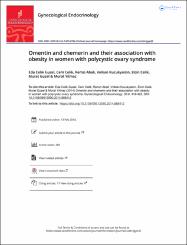Omentin and chemerin and their association with obesity in women with polycystic ovary syndrome

View/
Access
info:eu-repo/semantics/closedAccessDate
2014Author
Guzel, Eda CelikCelik, Cem
Abali, Remzi
Kucukyalcin, Volkan
Celik, Elcin
Guzel, Murat
Yilmaz, Murat
Metadata
Show full item recordAbstract
We aimed to investigate whether overweight/obesity is associated with omentin and chemerin. The study group consisted of 81 women with Polycystic ovarian syndrome (PCOS) (41 lean, BMI<25 kg/m(2) and 40 overweight or obese, BMI>25 kg/m(2)) and 61 healthy subjects (31 lean, BMI<25 kg/m(2) and 30 overweight or obese, BMI>25 kg/m(2); control group). The clinical, endocrine, metabolic parameters, plasma omentin and chemerin levels were measured in patients and compared to control. In all subjects with PCOS (n = 80), serum chemerin levels were higher compared with those of the controls (n = 58) (7.71 +/- 1.78 ng/mL versus 6.94 +/- 0.82 ng/mL, p = 0.003). However, serum omentin levels were not significantly different between the PCOS subjects and the controls (1.55 +/- 0.43 ng/mL versus 1.69 +/- 0.37 ng/mL, p = 0.056). The mean chemerin concentrations were significantly elevated in the obese PCOS group compared with the obese control subjects (8.98 +/- 1.45 ng/mL versus 7.02 +/- 0.67 ng/mL, p = 0.000) and the nonobese PCOS group compared with the obese control subjects (6.57 +/- 1.17 ng/mL versus 7.02 +/- 0.67 ng/mL, p = 0.000). In conclusion, fat mass seems to be the main determinant factor of increased chemerin and decreased omentin in women with PCOS.

















